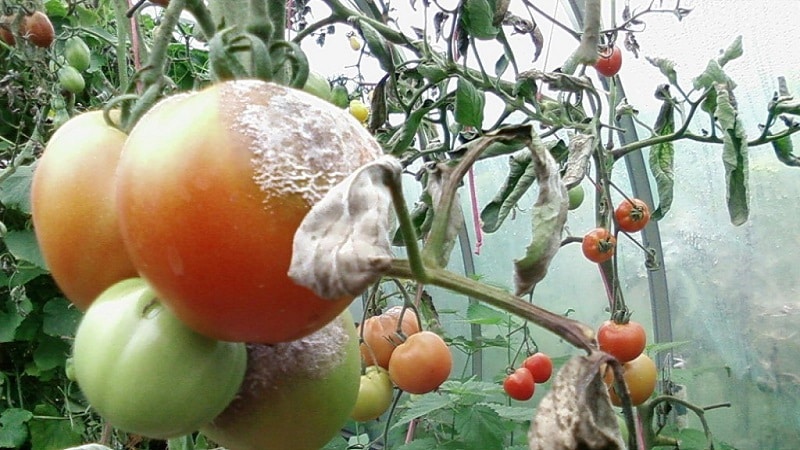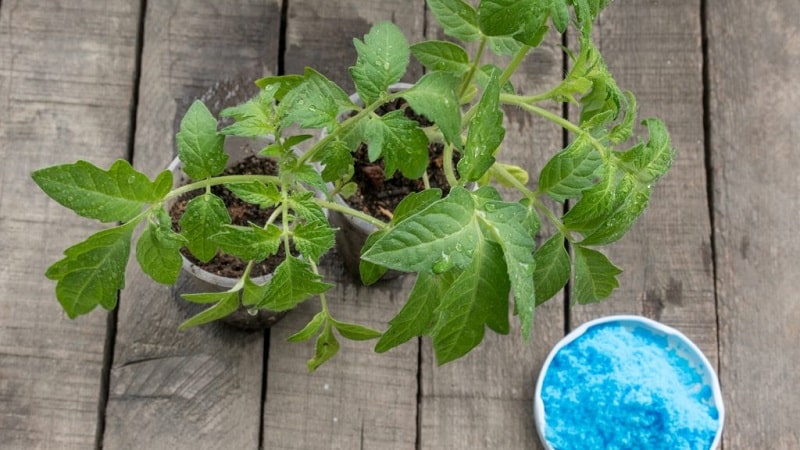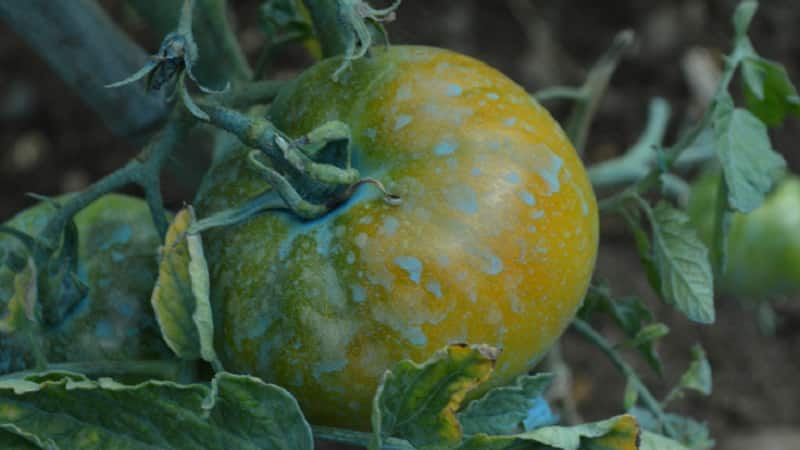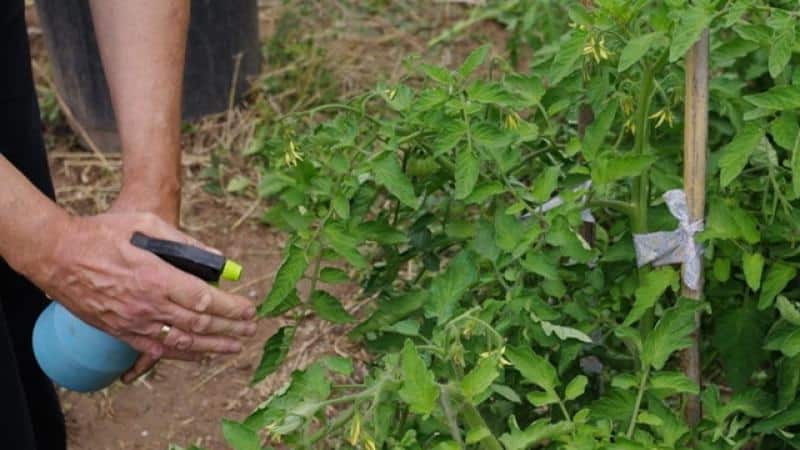How to properly use copper sulfate against late blight on tomatoes: step-by-step instructions and useful recommendations
Tomato yield losses due to late blight are 70% or more. However, there are effective drugs to combat such a terrible disease. One of them is copper sulfate.
Let's look at how to prepare a solution and treat tomatoes with it so that the growing efforts do not end in the death of the plants, but are rewarded with a rich harvest.
What is late blight
Late blight (lat. phytophthora) is a genus of oomycete fungi that causes late blight. More than a hundred species of this pathogen are known, affecting coniferous and deciduous trees, raspberries, and strawberries. Summer residents are familiar with late blight of tomatoes and potatoes.

Fungal spores remain in the soil, on tops and weeds, in seeds and remain viable for 3-4 years even in harsh climatic conditions. Late blight spreads from area to area on the soles of shoes, and is carried by wind and rain several kilometers from the source of infection. Spores are activated at moderate temperatures (15–20 °C) and relative humidity above 75%. Phytophthora requires drip moisture for germination.
In central Russia, late blight begins to appear in late July - early August. This is facilitated by cold weather with prolonged rains, sudden temperature changes during the day, causing heavy dew and fog.
3-4 days after infection, signs of disease appear on tomato plants.:
- dark spots without clear boundaries on leaves and stems that quickly grow and merge together;
- depressed brown spots of irregular shape on the fruit;
- after 2-3 days, a gray coating is visible on the surface of the spots - the sporulation organs of the fungus.
On a note. In late blight, the rot is hard (dry), in contrast to putrefactive lesions caused by bacteria and other fungi.
Why is it dangerous for tomatoes?
The particular danger of late blight is its rapid reproduction. After just 3-4 days, all the plants in the garden are affected. The bushes darken and wither.
Crop losses can be catastrophic. Fruits affected by rot are not suitable for food either fresh or for preservation.
Pathogen spores accumulate in the soil, which jeopardizes future tomato plantings.

Copper sulfate for late blight
Low-cost copper sulfate has proven itself in the fight against late blight (crystalline copper sulfate hydrate). It is produced in the form of a blue crystalline powder, highly soluble in water. The substance belongs to hazard class 3 (moderately toxic) and is available in the assortment of any gardening store.
How it works
The fungicidal effect of copper sulfate is based on the interaction copper ions with protein and enzyme complexes of cells. These biochemical reactions cause irreversible changes and denaturation of proteins, which leads to the death of fungal spores.
Read also:
Treating tomatoes against late blight in a greenhouse: a review of the best means
How to fight late blight on tomatoes in a greenhouse using traditional methods
The best varieties of tomatoes for the greenhouse, resistant to late blight
Efficiency
Copper sulfate is used only for the purpose of prevention, for the full treatment of late blight, special narrow-acting drugs are required. The reason is that copper-containing compounds only affect spores and have no effect on sprouted mycelium.
Copper sulfate solutions:
- treat the seeds before planting;
- during the growing season, seedlings and adult bushes are sprayed;
- disinfect the soil and greenhouse structures.
2 hours after use, the components of the drug begin to act actively. The therapeutic and prophylactic effect lasts up to 2 weeks.
How to prepare the solution
The required amount of crystals is dissolved in 500–700 ml of warm (40–50 °C) water. When stirring, bring the volume to 10 liters. Before pouring into the sprayer, the resulting liquid is filtered.
Attention! To avoid oxidation, do not use metal containers for dissolution.
Proportions and cooking instructions
For soil treatment, seed preparation and spraying solutions of different concentrations are used on the sheet.
| Purpose of processing | Solution concentration | Cooking method |
| Soil disinfection | 1% | Dissolve 100 g of the drug in 10 liters of warm water. |
| Seed preparation | 0,1% | Dissolve 1 g (1/5 teaspoon) of the substance in 1 liter of water. |
| Spraying tomatoes | 0,2% | Grate 200 g of laundry soap and dissolve in 1 liter of hot water. In a glass liter jar, separately dilute 20 g (one matchbox without a slide) of copper sulfate. While stirring, pour the drug solution into soapy water and increase the volume with cold water to 10 liters. |
Processing rules
In contact with skin and mucous membranes Copper sulfate causes burns and irritation, so when using it, use protection for the eyes, hands and face (glasses, gloves, bandage).
Soil preparation
Disinfect the soil with a 1% fungicide solution. The soil, both in open beds and in greenhouses, is prepared in the fall:
- remove all plant debris and weeds;
- dig up and break up the lumps.
The soil is spilled with a solution of copper sulfate, spending no more than 2 liters per 1 m2. The soil and containers intended for growing seedlings are generously moistened with the same solution from a spray bottle.
Attention! In cases of constant mass damage by late blight, a 3–5% solution of vitriol is used. Crops are not planted on soil treated with this product for a year.
Seed treatment
To get rid of late blight spores and other pathogenic microorganisms, tomato seeds are pickled with a weak (0.1%) solution of copper sulfate.
The seeds are soaked in the solution for a day. Then take it out, rinse thoroughly with running water and dry, making sure that they do not stick together.
And more about the fight against late blight on tomatoes:
Boric acid from late blight on tomatoes
Will brilliant green for tomatoes help against late blight and how to use it
Plant treatment
Spray tomato bushes leaf by leaf until signs of late blight appear. at the rate of 1 liter of 0.2% solution per 10 m2. A solution of higher concentration will burn the plant tissue.
The scheme of work is as follows:
- the first treatment is carried out a week after planting the seedlings in a greenhouse or open ground;
- the second spraying - with the onset of cold nights in August;
- if the summer is rainy, a fungicide solution is applied every 2 weeks.
Plants are treated in dry, windless weather, making sure to also wet the inside of the foliage. The last spraying is carried out at least 7 days before harvesting the fruits..
Attention! Copper sulfate is not absorbed by the plant, but remains on the surface of the leaves and fruits.Therefore, tomatoes are thoroughly washed in running water before use.

What to do in case of overdose
Uncontrolled use of copper sulfate and other copper-containing drugs leads to the accumulation and excess of copper in the soil.
Poisoning of tomatoes occurs, which manifests itself in the form of chlorosis of leaves:
- the processes of chlorophyll formation are disrupted, photosynthesis activity decreases;
- leaves turn yellow prematurely and fall off.
If similar symptoms appear soon after treatment copper sulfate plantings:
- Water the beds once with a large amount of water (10–12 liters per 1 m2). This will help transfer excess minerals to deeper layers of soil.
- Stop using copper-containing drugs and use other means against late blight (for example, Fitosporin, Planriz, Furacilin).

Tips and tricks from experienced farmers
Many summer residents and farmers are familiar with late blight of tomatoes. A few tips from experienced vegetable growers will be useful in the fight against this dangerous disease.:
- Bushes overloaded with fruits are the first to be affected by the disease. Leave 3-4 tomatoes on the first three clusters, thin out the foliage on the lower and middle tiers. It is important to do this on tall and large-fruited varieties.
- Do not use sprinkling for watering. Droplets of water on the tops are friends of late blight. It is more correct to carry out root (manual or drip) watering.
- More often, late varieties suffer from late blight - their fruiting and mass ripening occur during the period of fungal activity. It is safer to plant early or mid-season varieties.
Conclusion
Late blight leads to partial or complete loss of crops.The disease develops in cool, damp weather and affects plants both in open beds and in greenhouses.
To prevent late blight infection of tomatoes, solutions of copper sulfate (copper sulfate) are used. The product is used to disinfect the soil, treat seeds, and spray adult plants during the growing season. However, the drug only kills fungal spores. Therefore, when signs of late blight appear, fungicides with narrowly targeted action are used.